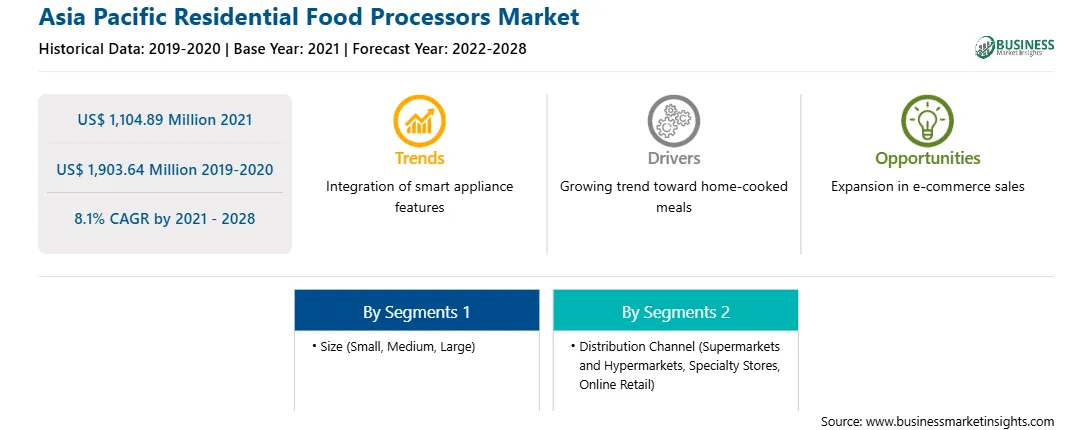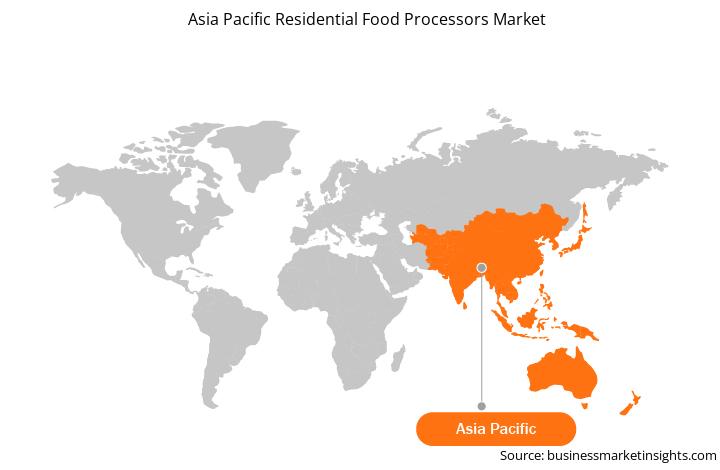In recent years, there have been various technological advancements in the residential food processor market. The manufacturing companies are increasing their focus on innovation and providing new products to enhance the customer experience. BOSCH GmbH developed a smart food processor Cookit, a smart kitchen helper that saves time and effort. Moreover, Cookit is a multifunctional food processor that replaces nearly the entire complement of kitchen equipment. The appliance has more than 140 recipes that have been pre-programmed into its memory. The information in the display guides a user through the preparation step by step. Also, Cookit has two sensors that constantly monitor the temperature in the processor's work bowl, comparing it with the temperature recommended for the given ingredient. The electronic control unit of the appliance is Wi-Fi-enabled, which turns Cookit into the hub of the connected kitchen. BSH Hausgeräte GmbH’s Home Connect app can download even more recipes to the food processor, and Alexa, Amazon’s virtual voice assistant, can be used to access this archive. The Sharkninja Operating LLC Company developed a 3-in-1 food processor that is a food processor, multi-serve blender, and personal blender all in one. Also, the appliance has Auto-IQ technology, which delivers the result at the touch of a button. Five unique pulse, pause, blend, and process patterns are present and do all the work automatically. Thus, there will be many innovations in food processors in the coming years, which will become a future trend in the residential food processor market.
With new features and technologies, vendors can attract new customers and expand their footprints in emerging markets. This factor is driving the growth of Asia Pacific residential food processors market at a substantial CAGR.
The Asia Pacific residential food processors market is segmented on the basis of size, distribution channel, and country. Based on size, the market is segmented into small, medium, and large. In 2020, the medium segment held the largest market share; however, the small segment is expected to register the highest CAGR during the forecast period. Based on distribution channel, the Asia Pacific residential food processors market is segmented into supermarkets and hypermarkets, specialty stores, online retail, and others. In 2020, the specialty stores treatment segment held the largest market share; however, the supermarkets and hypermarkets segment is expected to register the highest CAGR during the forecast period. Further, based on country, the Asia Pacific residential food processors market is segmented into Australia, China, India, Japan, South Korea, and the Rest of Asia Pacific. In 2020, China held the largest market share; however, India is expected to grow at the fastest CAGR during the forecast period.
Koninklijke Philips N.V.; Whirlpool Corporation; Breville Group Limited; De’Longhi Appliances S.r.l.; Robert Bosch GmbH; MAGIMIX; Groupe SEB; Spectrum Brands, Inc.; and SharkNinja Operating LLC are among the leading companies in the Asia Pacific residential food processors market.
Strategic insights for the Asia Pacific Residential Food Processors provides data-driven analysis of the industry landscape, including current trends, key players, and regional nuances. These insights offer actionable recommendations, enabling readers to differentiate themselves from competitors by identifying untapped segments or developing unique value propositions. Leveraging data analytics, these insights help industry players anticipate the market shifts, whether investors, manufacturers, or other stakeholders. A future-oriented perspective is essential, helping stakeholders anticipate market shifts and position themselves for long-term success in this dynamic region. Ultimately, effective strategic insights empower readers to make informed decisions that drive profitability and achieve their business objectives within the market.

| Report Attribute | Details |
|---|---|
| Market size in 2021 | US$ 1,104.89 Million |
| Market Size by 2028 | US$ 1,903.64 Million |
| Global CAGR (2021 - 2028) | 8.1% |
| Historical Data | 2019-2020 |
| Forecast period | 2022-2028 |
| Segments Covered |
By Size
|
| Regions and Countries Covered | Asia-Pacific
|
| Market leaders and key company profiles |
The geographic scope of the Asia Pacific Residential Food Processors refers to the specific areas in which a business operates and competes. Understanding local distinctions, such as diverse consumer preferences (e.g., demand for specific plug types or battery backup durations), varying economic conditions, and regulatory environments, is crucial for tailoring strategies to specific markets. Businesses can expand their reach by identifying underserved areas or adapting their offerings to meet local demands. A clear market focus allows for more effective resource allocation, targeted marketing campaigns, and better positioning against local competitors, ultimately driving growth in those targeted areas.

The Asia Pacific Residential Food Processors Market is valued at US$ 1,104.89 Million in 2021, it is projected to reach US$ 1,903.64 Million by 2028.
As per our report Asia Pacific Residential Food Processors Market, the market size is valued at US$ 1,104.89 Million in 2021, projecting it to reach US$ 1,903.64 Million by 2028. This translates to a CAGR of approximately 8.1% during the forecast period.
The Asia Pacific Residential Food Processors Market report typically cover these key segments-
The historic period, base year, and forecast period can vary slightly depending on the specific market research report. However, for the Asia Pacific Residential Food Processors Market report:
The Asia Pacific Residential Food Processors Market is populated by several key players, each contributing to its growth and innovation. Some of the major players include:
The Asia Pacific Residential Food Processors Market report is valuable for diverse stakeholders, including:
Essentially, anyone involved in or considering involvement in the Asia Pacific Residential Food Processors Market value chain can benefit from the information contained in a comprehensive market report.